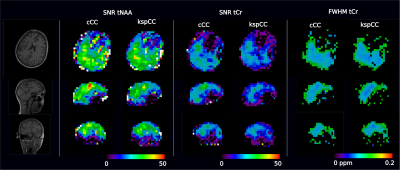Stanislav Motyka1, Lukas Hingerl1, Bernhard Strasser1, Gilbert Hangel1, Eva Heckova1, Asan Agibetov2, Georg Dorffner2, and Wolfgang Bogner1
1Department of Biomedical Imaging and Image-guided Therapy, Medical University of Vienna, Wien, Austria, 2Section for Artificial Intelligence and Decision Support (CeMSIIS), Medical University of Vienna, Wien, Austria
1Department of Biomedical Imaging and Image-guided Therapy, Medical University of Vienna, Wien, Austria, 2Section for Artificial Intelligence and Decision Support (CeMSIIS), Medical University of Vienna, Wien, Austria
MRSI data of volunteers were coil combined in non-Cartesian kspace via Geometric Deep Learning. The results were compared to conventional coil combination, providing similar results. The method can be used to strongly accelerate image reconstruction.

Figure 5 - Metabolic maps of tNAA/tCr and tCho/tCr and example spectra from two locations are presented for both coil combination methods. The contrast of the ratio maps appear similar in all three orthogonal projection for both methods. The position are marked with the small letters. The spectra in the same column belong to the same coil combination method. The appearance of the spectra for different methods differ mainly in the course of the baseline.

Figure 2 – Comparison of kspCC and cCC maps of the spectral data quality. Both methods produced similar results in terms of spatial distribution of parameters. The SNR values for kspCC are a bit lower compared to the cCC but approximately the same volume is covered. The FWM maps look very similar and from the maps themselves no underperformance can be observed.
